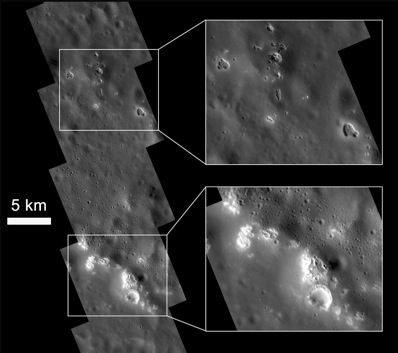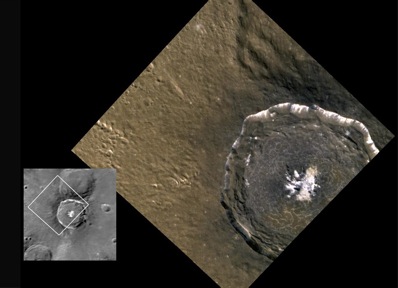



|

|

MESSENGER begins unlocking Mercury's secrets
DR EMILY BALDWIN
ASTRONOMY NOW
Posted: 20 June 2011


After nearly three months in orbit around the innermost planet, the MESSENGER (MErcury Surface, Space ENvironment, GEochemistry, and Ranging) spacecraft is already providing new insights into the planet's geochemistry, geology, magnetosphere and plasma environment.
MESSENGER entered orbit around Mercury on 18 March following a seven year journey that saw it make three close fly-bys of its target before settling into orbit, where it will perform detailed observations for at least three years.

Previous images hinted at unusual high-reflectance features associated with impact crater floors. High-resolution (21 m/pixel) monochrome images reveal these features to be rimless, irregular pits varying in size from hundreds of meters to up to several kilometers. These pits are often surrounded by diffuse halos of higher-reflectance material, and they are found associated with central peaks, peak rings, and rims of craters. The unusual etched appearance of these landforms may suggest a higher than expected volatile component in Mercury’s crust, and their sharp features are consistent with a relatively young age. Image: NASA/The Johns Hopkins University Applied Physics Laboratory/Carnegie Institution of Washington.
“MESSENGER has passed a number of milestones just this last week,” says principal investigator Sean Solomon of the Carnegie Institution of Washington. “We completed our first perihelion passage from orbit on Sunday, our first Mercury year in orbit on Monday, our first superior solar conjunction from orbit on Tuesday, and our first orbit-correction maneuver on Wednesday. Those milestones provide important context to the continuing feast of new observations that MESSENGER has been sending home on nearly a daily basis.”
Features on Mercury's surface – from impact craters to scarps and volcanic deposits – that were only previously seen at low resolution are now being brought into sharp focus, and the gaps in the global view of Mercury are being filled in to reveal a world dominated by volcanism. The new images show that the plains are likely among the largest expanses of volcanic deposits on Mercury, with thicknesses of up to several kilometres.

This spectacular view of 52 kilometre-wide crater Degas was obtained as a high-resolution targeted observation at 90 metres per pixel. Impact melt coats its floor, and as the melt cooled and shrank, it formed the cracks observed across the crater. Image: NASA/The Johns Hopkins University Applied Physics Laboratory/Carnegie Institution of Washington.
By measuring abundances of key elements on the surface, the X-Ray Spectrometer has confirmed that, unlike the Moon, Mercury's surface is not dominated by feldspar-rich rocks, instead revealing large amounts of sulphur, which suggests differences between Mercury's original building blocks and the other inner Solar System planets.
Earth-based radar observations that previously showed high backscatter in the polar regions and interpreted as ice deposits continues to be investigated by MESSENGER's altimeter, which is measuring the depths of craters near the north pole. So far, the data suggests that these craters are indeed in areas that remain in permanent shadow.

This region is part of the extensive northern plains, and evidence for a volcanic origin can now be seen. Several examples of “ghost” craters, preexisting craters that were buried by the emplacement of the plains, are seen near the center of the mosaic. Image: NASA/The Johns Hopkins University Applied Physics Laboratory/Carnegie Institution of Washington.
Turning to Mercury's magnetic field, MESSENGER has found that the magnetic field of Mercury is much like that of the Earth in that it has a north pole and south pole, each approximately aligned with the corresponding geographic pole. However, unlike on Earth, the magnetic equator on Mercury is offset about 480 kilometres northward of Mercury’s geographic equator. “This is an exciting result that suggests something fundamentally different about what processes play a key role in the generation of Mercury’s magnetic field compared with those important to Earth’s magnetic field,” says MESSENGER scientist Catherine Johnson. “The result may have important implications for the internal dynamics of the planet and how the planet cools today.”

One of the many striking features seen during the first few months of orbital operations. At 9.0° S, 254.7° E, impact melt flowed from an unnamed, 13-km-diameter impact crater, extending outward more than one crater diameter from the rim. In contrast to impact melt observed at other craters on Mercury, this flow is low in reflectance and appears to be compositionally distinct from its surroundings – a confirmation that Mercury’s crust is heterogeneous both vertically and laterally on relatively small scales. Image: NASA/The Johns Hopkins University Applied Physics Laboratory/Carnegie Institution of Washington.
Bursts of energetic particles in Mercury's magnetosphere first seen by Mariner 10 in 1974, but with no significant events during MESSENGER's flybys, are now being seen again, regularly. The generation and distribution of these events will be another focus of observations over the coming months.
“We are assembling a global overview of the nature and workings of Mercury for the first time and many of our earlier ideas are being cast aside as new observations lead to new insights,” says Solomon. “Our primary mission has another three Mercury years to run, and we can expect more surprises as our Solar System’s innermost planet reveals its long-held secrets.
|

|

|

|
|



